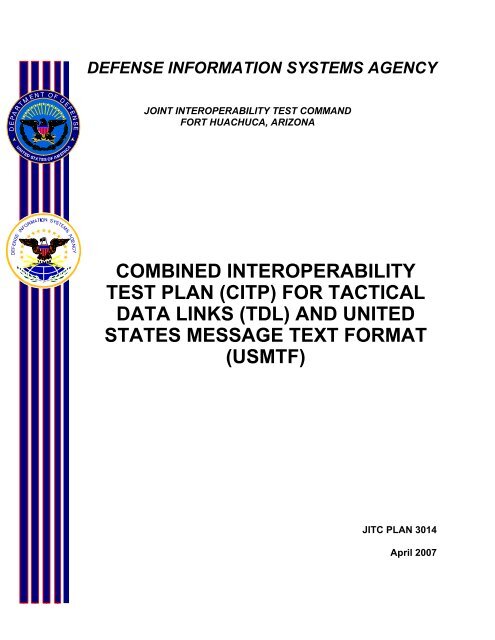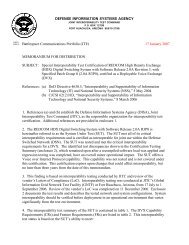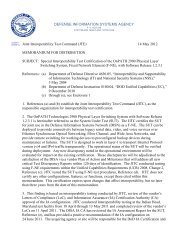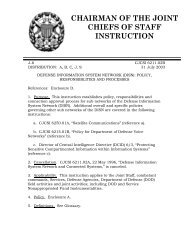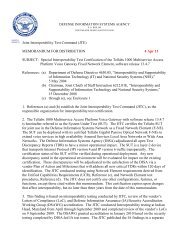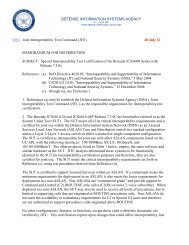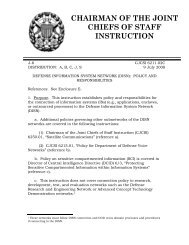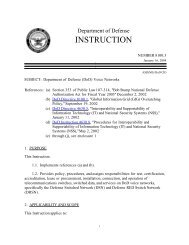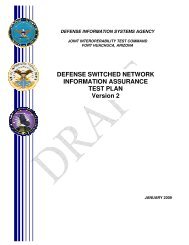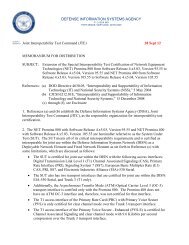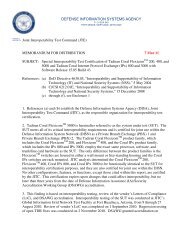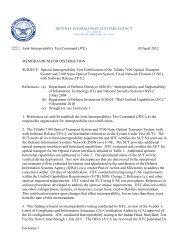combined interoperability test plan (citp) - Joint Interoperability Test ...
combined interoperability test plan (citp) - Joint Interoperability Test ...
combined interoperability test plan (citp) - Joint Interoperability Test ...
Create successful ePaper yourself
Turn your PDF publications into a flip-book with our unique Google optimized e-Paper software.
DEFENSE INFORMATION SYSTEMS AGENCY<br />
JOINT INTEROPERABILITY TEST COMMAND<br />
FORT HUACHUCA, ARIZONA<br />
COMBINED INTEROPERABILITY<br />
TEST PLAN (CITP) FOR TACTICAL<br />
DATA LINKS (TDL) AND UNITED<br />
STATES MESSAGE TEXT FORMAT<br />
(USMTF)<br />
JITC PLAN 3014<br />
April 2007
COMBINED INTEROPERABILITY<br />
TEST PLAN<br />
April 2007<br />
Submitted by: Byron Baker<br />
Chief<br />
Tactical Data Link Branch<br />
//signed//<br />
Approved by: ____________________________<br />
Timothy Albers, LTC<br />
Portfolio Chief<br />
Force Application/Force Protection<br />
Prepared by<br />
<strong>Joint</strong> <strong>Interoperability</strong> <strong>Test</strong> Command<br />
Fort Huachuca, Arizona 85613-7051
(This page intentionally left blank.)
EXECUTIVE SUMMARY<br />
United States Pacific Command (USPACOM) requested a standing document to<br />
provide guidance for <strong>interoperability</strong> <strong>test</strong>ing of Pacific Command (PACOM) Area of<br />
Responsibility (AOR) partner countries systems. This document is the overarching<br />
<strong>test</strong>ing guidance for <strong>Joint</strong> <strong>Interoperability</strong> <strong>Test</strong> Command (JITC) and partner countries<br />
with system(s) under <strong>test</strong> (SUT) for tactical data links (TDL) to include Link 11, Link<br />
11B, Link 16, and Variable Message Format (VMF), as well as United States Message<br />
Text Format (USMTF).<br />
The goal of this document is to provide basic guidance for <strong>plan</strong>ning, scheduling, <strong>test</strong>ing,<br />
and post <strong>test</strong> requirements. Additionally, it provides information regarding the scope of<br />
<strong>test</strong>ing, limitations and methodology of <strong>test</strong>ing.<br />
Once a <strong>test</strong> is scheduled for a foreign system, JITC will provide in-depth <strong>test</strong> procedures<br />
for the system to be <strong>test</strong>ed in accordance with JITC policies and procedures.<br />
i
(This page intentionally left blank.)<br />
ii
TABLE OF CONTENTS<br />
EXECUTIVE SUMMARY ................................................................................................. i<br />
TEST BACKGROUND .................................................................................................... 1<br />
TEST PURPOSE............................................................................................................. 1<br />
REQUIREMENTS ........................................................................................................... 1<br />
SCOPE............................................................................................................................ 2<br />
LIMITATIONS.................................................................................................................. 3<br />
METHODOLOGY ........................................................................................................... 3<br />
APPENDICES<br />
A. ACRONYMS ...........................................................................................................A-1<br />
B. TEST SCHEDULES AND MILESTONES ...............................................................B-1<br />
C. TEST REPORT FORMAT ..................................................................................... C-1<br />
D. CONFIGURATION DIAGRAMS............................................................................. D-1<br />
E. DATA LINK DESCRIPTION ....................................................................................E-1<br />
F. REFERENCES........................................................................................................F-1<br />
G. PRELIMINARY TROUBLE REPORTS ................................................................. G-1<br />
H. TACTICAL DATA LINK (TDL) PTR INSTRUCTIONS ........................................... H-1<br />
I. US MESSAGE TEXT FORMAT (USMTF) PTR INSTRUCTIONS ............................ I-1<br />
J. ANALYSIS REVIEW PANEL (ARP) PROCEDURES ............................................. J-1<br />
LIST OF ENCLOSURES<br />
TDL Preliminary Trouble Report............................................................................... H-1-1<br />
USMTF Preliminary Trouble Report ...........................................................................I-1-1<br />
LIST OF FIGURES<br />
D-1 Representative Link Configuration for a Link 11/Link 16 System Under <strong>Test</strong>... D-1<br />
LIST OF TABLES<br />
C-1 Sample TR Summary Table ............................................................................. C-2<br />
C-2 Sample Functional Area Status Table .............................................................. C-2<br />
C-3 Sample TDL <strong>Test</strong>ing Summary Matrix.............................................................. C-4<br />
iii
(This page intentionally left blank.)<br />
iv
TEST BACKGROUND<br />
Tactical Data Link (TDL) Combined <strong>Interoperability</strong> <strong>Test</strong>ing (CIT) is required IAW United<br />
States Pacific Command’s (USPACOM’s) Combined Communications <strong>Interoperability</strong><br />
Program (CCIP) and applicable bilateral Memorandum of Agreements (MOAs) with<br />
<strong>combined</strong> nations. The JITC is the designated <strong>interoperability</strong> <strong>test</strong> agency for the<br />
Defense Information Systems Agency (DISA) and has been providing the <strong>test</strong>ing for<br />
TDL and United States Message Text Formatting (USMTF) systems. TDL consists of<br />
Link 11, Link 11B, Link 16, and Variable Message Format (VMF). TDLs and USMTF<br />
are further described in appendix E.<br />
TEST PURPOSE<br />
The U.S. joint <strong>interoperability</strong> programs provide the basis for U.S. initiatives toward<br />
achieving <strong>combined</strong> <strong>interoperability</strong> with allied and friendly nations. <strong>Test</strong>ing TDL<br />
systems and USMTF information exchange in a <strong>combined</strong> environment provides<br />
relevant, statistical information regarding <strong>interoperability</strong> with the participating nations.<br />
Some <strong>interoperability</strong> <strong>test</strong>ing will be required in an operational environment to validate<br />
the level of <strong>interoperability</strong> with the operators and equipment in place.<br />
REQUIREMENTS<br />
JITC will promulgate available <strong>test</strong> windows approximately 18 months in advance.<br />
Combined partners operating with PACOM in the CCIP who wish to participate in a TDL<br />
CIT will nominate a system for <strong>test</strong> at the appropriate Command and Control<br />
<strong>Interoperability</strong> Board (CCIB) or <strong>Interoperability</strong> Management Board (IMB). PACOM<br />
J61 will establish a <strong>test</strong> priority and request JITC conduct the <strong>test</strong>.<br />
Combined partners will only nominate systems that have been evaluated for standards<br />
conformance for the appropriate interface. JITC may waive this requirement in the rare<br />
instance that it could benefit the <strong>test</strong> but only with the approval of all <strong>test</strong> participants.<br />
The country scheduled for <strong>test</strong>ing will provide a system implementation document<br />
indicating message implementation down to the field level and a system description<br />
document if available, no later than six months prior to the <strong>test</strong> date. In addition they<br />
will provide the software version numbers for each application involved in the <strong>test</strong>.<br />
JITC will ask each United States (U.S.) Service and Agency (S/A) to provide a tactical<br />
data system (TDS) to participate in each TDL CIT. JITC will attempt to have at least<br />
one moving TDS present during all TDL CITs in order to <strong>test</strong> the exchange of positional<br />
data.<br />
JITC will staff a yearly Memorandum of Agreement (MOA) between scheduled U.S.<br />
Forces, JITC and applicable combatant commanders (COCOMs). This MOA replaces<br />
the System Security Verification (SSV) document. It is implied that COCOMs maintain<br />
valid Communication Information System Memorandum of Agreements<br />
(CISMOAs)/MOAs between the host country and PACOM and those documents define<br />
1
the requirements to safeguard tactical data exchange between the host country and<br />
U.S. Forces.<br />
SCOPE<br />
Link 11/11B/Link 16<br />
For Link 11 and Link 16 <strong>test</strong>ing, the JITC's <strong>Joint</strong> Tactical Data Link Laboratory (JTDLL)<br />
uses the <strong>Joint</strong> <strong>Interoperability</strong> Modular Evaluation System (JIMES), Multi-link System<br />
<strong>Test</strong> and Training Tool (MLST3), and the Dual Link System (DLS) or a Battlefield<br />
Operations Simulation System (BOSS) to conduct the TDL CIT. The JIMES connects<br />
with U.S. S/As’ TDSs located at Operational Facilities (OPFACs) throughout the<br />
Continental United States (CONUS). Systems not located at one of the OPFACs may<br />
be connected through a dial-up phone line. In addition to <strong>test</strong> tools, JITC has the ability<br />
to provide a <strong>Joint</strong> Air Defense Systems Integrator (JADSI) as an operational system for<br />
the <strong>test</strong>. The JIMES contains the hardware and software necessary to conduct and<br />
evaluate <strong>test</strong> operations. Sensor stimulators are used to generate sensor inputs to S/A<br />
systems within CONUS when required.<br />
The distributed sites involved in <strong>test</strong>ing are linked together by secure voice and<br />
encrypted digital data links. The SUT will be linked to the secure voice via Secure<br />
Telephone Unit (STU)-IIIs or the new generation of Secure Telephone Equipment<br />
(STE).<br />
An overview configuration for Link 11/16 <strong>test</strong>ing is shown in appendix D, figure D1.<br />
VMF<br />
JITC uses various <strong>test</strong> collection and analysis equipment, including but not limited to the<br />
Army’s VMF <strong>Test</strong> Tool (VTT), JITC’s VMF Link Processor and Bit Oriented Module<br />
Editor (JVLP/BOM), the Army’s Common Message Processor (CMP), JITC’s JIMES,<br />
and the Theater Air Missile Defense <strong>Interoperability</strong> Assessment Capability (TIAC) suite<br />
of tools as part of JITC’s Net-Centric Enterprise Services (NCES) lab.<br />
For <strong>test</strong>ing specific to VMF capable systems, JITC requires the systems’<br />
implementation down to the data item level as specified in the Variable Message Format<br />
Master <strong>Test</strong> Procedure. For <strong>interoperability</strong> <strong>test</strong>ing of VMF capable systems, JITC<br />
requires the system requirements in order to develop in order to develop operationally<br />
relevant <strong>test</strong> scenarios.<br />
USMTF<br />
There are no current requirements to conduct USMTF Combined <strong>Interoperability</strong> <strong>Test</strong><br />
(CIT) events. When this type of <strong>test</strong>ing is required, it is imperative that the SUT provide<br />
detailed information on their USMTF message implementation. JITC will develop <strong>test</strong><br />
procedures and <strong>test</strong> messages based on this information and the USMTF information<br />
exchange requirements of the SUT. The information exchange requirements detail<br />
2
what other systems the SUT exchanges USMTF information with, and how those<br />
messages will be exchanged.<br />
JITC will provide <strong>test</strong> procedures and <strong>test</strong> messages to the SUT for review and to allow<br />
them to conduct their own pre-<strong>test</strong> activities. JITC will provide <strong>test</strong> messages on<br />
magnetic media or via e-mail. JITC will design the <strong>test</strong> procedures to <strong>test</strong> each USMTF<br />
message type used by the SUT, and JITC-built messages will consist of a<br />
representative sample of the segments, sets, fields, and data items implemented by the<br />
SUT. <strong>Test</strong>ing will include the transmission and receipt of pre-built, manually-entered, or<br />
system-generated messages (based on system capabilities and requirements). <strong>Test</strong>ers<br />
will observe, document, and analyze results of <strong>test</strong>ing through the use of visual<br />
displays, graphical user interfaces (GUIs), hard copy printouts, output from system<br />
databases, or other available means. <strong>Test</strong>ers will use JITC-certified USMTF <strong>test</strong> tools<br />
or message processors to determine the compliance of all USMTF <strong>test</strong> messages with<br />
Military Standard 6040, US Message Text Formatting Program.<br />
Current USMTF <strong>interoperability</strong> <strong>test</strong>ing is generally conducted on-site (either at JITC or<br />
the SUT’s location) and not done via a distributed network. The methodology used for<br />
USMTF CIT <strong>test</strong>ing and data collection will be based on the requirements of the SUT<br />
and the availability of resources to conduct the event.<br />
JITC can also observe/review the results of USMTF <strong>test</strong>ing activity that occurs in<br />
<strong>combined</strong> exercise events. Due to the varying nature of these events, JITC will<br />
determine data collection requirements and methods on a case by case basis.<br />
STANDARDS CONFORMANCE TESTING<br />
JITC can provide standards conformance <strong>test</strong>ing and certification of a <strong>combined</strong><br />
system. However, this type of event would be done on a reimbursable cost basis<br />
outside of a TDL or USMTF CIT event.<br />
LIMITATIONS<br />
The TDL CIT configuration is a controlled laboratory environment. Because of this, the<br />
operational realism of sensor input, operator interaction, sensor registration effects and<br />
environmental propagation are not available. In addition, emulators are used vice Link<br />
16 terminals; therefore, most of the network management and host/terminal<br />
requirements are not evaluated.<br />
METHODOLOGY<br />
After scheduling a <strong>combined</strong> system for a TDL CIT, JITC will write the <strong>test</strong> procedures<br />
to support the SUT. The <strong>test</strong> procedures will detail the information and provide<br />
guidance required for the <strong>test</strong> conduct from initiation to completion and are in sufficient<br />
detail to provide each <strong>test</strong> participant with a clear understanding of the <strong>plan</strong>ned <strong>test</strong><br />
activities. <strong>Test</strong> procedures are prepared by JITC and sent to the SUT <strong>test</strong> lead via<br />
PACOM J61 for their inputs prior to JITC producing the Final <strong>Test</strong> Procedures. The <strong>test</strong><br />
3
procedures specify <strong>test</strong> objectives and performance criteria and contain the individual<br />
<strong>test</strong> events that must be executed to ensure <strong>test</strong> objectives are met. Special instructions<br />
are included for clarification when necessary. At a minimum, <strong>test</strong> procedures will<br />
include:<br />
•Identification of required resources and participants.<br />
•<strong>Test</strong> configuration.<br />
•<strong>Test</strong> objectives.<br />
•Performance criteria.<br />
•<strong>Test</strong> events - detailed procedures for <strong>test</strong> conduct.<br />
•Analysis procedures.<br />
•Special instructions (as required).<br />
•Data collection, recording, and reduction requirements.<br />
•Network designs, as required.<br />
•Trouble Reports (TRs) declared ready for <strong>test</strong>.<br />
If necessary, and as coordinated with the host country, JITC will conduct a site survey and<br />
a Communications Dry Run several weeks prior to the actual <strong>test</strong> to ensure connectivity<br />
and data exchange.<br />
The TDL CIT is usually conducted in a one-week period, 8-10 hours per day, Monday<br />
through Friday in the US. This equates to a Tuesday through Saturday daytime event<br />
for the <strong>combined</strong> country. <strong>Test</strong> start times vary according to <strong>test</strong> laboratory availability.<br />
Participants and SUT will establish TDL connectivity and voice communications one<br />
hour prior to <strong>test</strong>.<br />
The JITC <strong>Test</strong> Director (TD) controls <strong>test</strong> conduct in coordination with the <strong>test</strong> leads of<br />
participating systems. The SUT is exercised by exchanging messages based on <strong>test</strong><br />
events and stimulated sensors to <strong>test</strong> conformance and confirming <strong>interoperability</strong> in<br />
accordance with the applicable MIL-STDs and system implementation. Neither<br />
participating systems nor their connectivity configuration shall be altered during a <strong>test</strong><br />
without concurrence of JITC and all participating <strong>test</strong> leads.<br />
During TDL <strong>test</strong> execution, the participants and JITC will monitor, record, and extract<br />
<strong>test</strong> data IAW the "Multi-TDL Data Extraction & Reduction Guide" (DERG) (Appendix F)<br />
to support post-<strong>test</strong> analysis. This Data Extraction (DX) is reduced and uploaded (for<br />
U.S. systems) to the JITC TDL web page on the Secret Internet Protocol Router<br />
Network (SIPRNET) on a daily basis during <strong>test</strong>ing. This data is accessible to the U.S.<br />
Participants for further analysis. The SUT’s DX should be reduced and uploaded via<br />
secure telephone or sent to JITC via other means (whichever is more practical) for use<br />
by the U.S. participants during post-<strong>test</strong> analysis.<br />
All the <strong>test</strong> participants will perform on-line or real-time analysis, enabling an opportunity<br />
to determine if <strong>test</strong> events that produced questionable results should be repeated and<br />
provide a good way to document issues as they happen.<br />
Each participant will conduct definitive analysis that addresses all functional areas<br />
exercised during <strong>test</strong>ing. This includes identification of problem identification in<br />
message implementation and processing as well as problems with the standard. Any<br />
problems that occur during <strong>test</strong>ing are documented as PTRs for later analysis.<br />
4
As required, <strong>test</strong> participants and JITC will write Preliminary Trouble Reports (PTRs).<br />
Refer to appendices H and I for further information. JITC will consolidate the PTRs to<br />
be published as an agenda for review by the Analysis Review Panel (ARP).<br />
At any time during <strong>test</strong> conduct, the <strong>test</strong> lead of the SUT may determine it appropriate<br />
to discontinue <strong>test</strong>ing and declare a NO TEST. Normally this declaration automatically<br />
cancels the post-<strong>test</strong> analysis and the ARP for the SUT. If a NO TEST is declared, the<br />
<strong>test</strong> will continue only if there is another SUT to evaluate.<br />
JITC convenes the ARP to review and finalize the disposition of the PTRs and<br />
determine actions to resolve those problems identified as a result of <strong>test</strong>ing. The ARP<br />
will provide an <strong>interoperability</strong> recommendation based on technical and operational<br />
evaluation of the SUT’s performance in the <strong>test</strong>. ARPs are generally convened<br />
approximately four to six weeks after each TDL CIT, and are normally a one (1) day<br />
event.<br />
JITC recommends a representative from the SUT attends the ARP to participate in<br />
discussions regarding their system. Attendees should be fully knowledgeable of system<br />
functions and be ready to discuss all PTRs written against the system and interface. If<br />
a representative is unable to attend JITC, upon request, can act on their behalf if<br />
supporting documentation for the PTRs is provided. If possible a secure video or<br />
teleconference, at that country’s expense, may be used in lieu of the SUT<br />
representative attending in person. ARP procedures are further described in appendix<br />
J.<br />
JITC publishes and distributes a <strong>test</strong> report approximately four weeks after the<br />
conclusion of the ARP. The <strong>test</strong> report summarizes ARP actions and includes ARP<br />
minutes. Multi-system <strong>test</strong>ing may increase the time required to publish and distribute a<br />
<strong>test</strong> report. The <strong>test</strong> report will provide an assessment of the <strong>interoperability</strong> of the<br />
<strong>combined</strong> system with U.S. systems, along with recommended modifications to improve<br />
<strong>interoperability</strong>. JITC will provide an electric copy of the <strong>test</strong> report via the SIPRNET to<br />
the USPACOM JITC Liaison Officer (LNO), who will coordinate distribution to HQ<br />
USPACOM<br />
5
(This page intentionally left blank.)<br />
6
APPENDIX A<br />
ACRONYMS<br />
ACDS Advanced Combat Direction System<br />
ACT SYS Action System<br />
AF Air Force<br />
AFB Air Force Base<br />
AMCOM Air and Missile Command<br />
AOR Area of Responsibility<br />
ARP Analysis Review Panel<br />
ATDS Air Tactical Data System<br />
AWACS Airborne Warning and Control System<br />
BPS bits per second<br />
BOSS Battlefield Operations Simulation System<br />
CIP Combined <strong>Interoperability</strong> Plan<br />
CISMOA Communication Information System Memorandum of Agreement<br />
C/S/A Combatant Commander/Services/Agencies<br />
C2 Command and Control<br />
CCB Configuration Control Board<br />
CCIB C2 <strong>Interoperability</strong> Board<br />
CECOM Communications and Electronics Command<br />
CIT Combined <strong>Interoperability</strong> <strong>Test</strong><br />
CITP Combined <strong>Interoperability</strong> <strong>Test</strong> Plan<br />
CLEW Conventional Link 11 Waveform<br />
CMP Common Message Processor<br />
COCOM Combatant Commander<br />
COM character-oriented message<br />
CONUS Continental United States<br />
CTL NO Control Number<br />
DAA Designated Approving Authority<br />
DERG Multi-TDL Data Extraction and Reduction Guide<br />
DIA Defense Intelligence Agency<br />
DISA Defense Information Systems Agency<br />
DISR DoD IT Standards Registry<br />
DLS Dual Link System<br />
A-1
DNCS Data Net Control Station<br />
DoD Department of Defense<br />
DTS Data Terminal Sets<br />
DX Data Extraction<br />
EDAC Error Detection and Correction<br />
FFIRN/FUDN Field Format Index Reference Number/Field Use Designator Number<br />
FH Fort Huachuca<br />
GMT Greenwich Mean Time<br />
HF High Frequency<br />
IAW in accordance with<br />
ICP Interface Change Proposal<br />
IDH Implementation Design Handbook<br />
IMB <strong>Interoperability</strong> Management Board<br />
IT Information Technology<br />
ITP <strong>Interoperability</strong> <strong>Test</strong><br />
JADSI <strong>Joint</strong> Air Defense Systems Integrator<br />
JIEO <strong>Joint</strong> Information and Engineering Organization<br />
JIMES <strong>Joint</strong> <strong>Interoperability</strong> Modular Evaluation System<br />
JITC <strong>Joint</strong> <strong>Interoperability</strong> <strong>Test</strong> Command<br />
JMAL <strong>Joint</strong> Message Analysis Laboratory<br />
JTDLL <strong>Joint</strong> Tactical Data Link Laboratory<br />
JTIDS <strong>Joint</strong> Tactical Information Distribution System<br />
JTRS <strong>Joint</strong> Tactical Radio System<br />
JVLP/BOM JITC’s VMF Link Processor and Bit Oriented Module Editor<br />
LOS Line Of Sight<br />
MAS Message Analysis System<br />
MCEB Military Communications-Electronics Board<br />
MIDS Multifunctional Information Distribution System<br />
MIL-STD Military Standard<br />
MLST3 Multi-link System <strong>Test</strong> and Training Tool<br />
MOA Memorandum of Agreement<br />
A-2
MSGID Message Identity<br />
MTF Message Text Formatting<br />
NCES Net-Centric Enterprise Services<br />
NCTSI Navy Center for Tactical Systems <strong>Interoperability</strong><br />
N-MLST3 Navy-MLST3<br />
NR-KPP Net-Ready Key Performance Parameter<br />
NSA National Security Agency<br />
OPFAC Operational Facilities<br />
OPR Office of Primary Responsibility<br />
ORIG NO Originator Number<br />
PCSAIMP Personal Computer for Service and Agency Implementation<br />
PTR Preliminary Trouble Report<br />
PTUC Primary <strong>Test</strong> Unit Coordinator<br />
PU Participating Unit<br />
R2 Reporting Responsibility<br />
S/A Services and Agencies<br />
SATCOM satellite communications<br />
SCT Standards Conformance <strong>Test</strong><br />
SIPRNET Secret Internet Protocol Router Network<br />
SIS(RJ) Special Information Systems (Rivet <strong>Joint</strong>)<br />
SLEW Single-tone Link 11 Waveform<br />
SSV System Security Verification<br />
STE Secure Telephone Equipment<br />
STU Secure Telephone Unit<br />
SUT System Under <strong>Test</strong> or Systems Under <strong>Test</strong><br />
TD <strong>Test</strong> Director<br />
TDL Tactical Data Link<br />
TDMA Time Division Multiple Access<br />
TDS Tactical Data System<br />
TIAC Theater Air Missile Defense <strong>Interoperability</strong> Assessment Capability<br />
TR Trouble Report<br />
TV Technical View<br />
A-3
UHF Ultra High Frequency<br />
U.S. United States<br />
USA United States Army<br />
USAF United States Air Force<br />
USCOCOM United States Combatant Commander<br />
USEUCOM United States European Command<br />
USMC United States Marine Corps<br />
USMTF United States Message Text Format<br />
USN United States Navy<br />
USPACOM United States Pacific Command<br />
VMF Variable Message Format<br />
VTT VMF <strong>Test</strong> Tool<br />
A-4
APPENDIX B<br />
TEST SCHEDULES AND MILESTONES<br />
The <strong>test</strong> windows for TDL CITs are determined approximately 18 months in advance<br />
based on laboratory and systems availability to support <strong>test</strong>ing. JITC schedules 4-5<br />
TDL CITs per year and countries should make recommendations for systems for <strong>test</strong> at<br />
least 12 months prior to the desired <strong>test</strong> date. A sample timeline of milestones in a TDL<br />
<strong>test</strong> cycle are listed below:<br />
TIMELINE MILESTONE<br />
PRIOR TO TEST<br />
24 WEEKS SUT IMPLEMENTATION DATA RECEIVED AT JITC<br />
14 WEEKS SUT SITE SURVEY (time may vary)<br />
23-8 WEEKS DRAFT TEST PROCEDURE DEVELOPED<br />
7-5 WEEKS SUT REVIEW OF DRAFT TEST PROCEDURE,<br />
COMMENTS TO JITC<br />
4 WEEKS SUT COMMENTS INCORPORATED<br />
2 WEEKS FINAL TEST PROCEDURES DISTRIBUTED<br />
1 WEEK PRE-TEST BRIEF CONDUCTED<br />
TEST WEEK TEST CONDUCT<br />
(data extraction (DX) loaded to JITC TDL web site<br />
daily by U.S. participants)<br />
POST TEST<br />
1-6 WEEKS POST-TEST ANALYSIS<br />
(PTRs written by all participants)<br />
7 WEEKS PTRS PROVIDED TO JITC<br />
(All analyze their PTRs. JITC consolidates PTRs into<br />
an ARP agenda)<br />
8 WEEKS ARP CONDUCTED<br />
10 WEEKS TEST REPORT DEVELOPED<br />
12 WEEKS TEST REPORT ISSUED<br />
B-1
(This page intentionally left blank.)<br />
B-2
APPENDIX C<br />
TEST REPORT FORMAT<br />
JITC will develop a <strong>test</strong> report for each CIT event, providing an overview of the <strong>test</strong><br />
objectives, <strong>test</strong> configuration, overall execution of the event, and a summary of any<br />
issues found during <strong>test</strong>ing. The CIT <strong>Test</strong> Report will be provided to PACOM J61, who<br />
will review the report and forward a copy to the appropriate <strong>combined</strong> country<br />
representative. Due to the discussion of problems found during <strong>test</strong>ing, the <strong>test</strong> report<br />
is normally classified CONFIDENTIAL.<br />
A TDL CIT <strong>Test</strong> Report normally includes the following sections:<br />
- Executive Summary<br />
- System Functional Description<br />
- <strong>Test</strong> Background<br />
- <strong>Test</strong> Purpose<br />
- Scope and Methodology<br />
- Limitations<br />
- Problem Identification Procedure<br />
- Results and Analysis<br />
- Recommendation<br />
The report will also include the following appendices:<br />
- Acronyms<br />
- <strong>Test</strong> Criteria and Procedures<br />
- Network Description and Configurations<br />
- Trouble Report Classes and Prefix Designations<br />
- Trouble Report Assessment Definitions<br />
- References<br />
- Assigned Trouble Reports<br />
A sample, unclassified TDL CIT <strong>Test</strong> Report is available for review upon request.<br />
The TDL CIT <strong>Test</strong> Report will include a summary of all new and existing TRs for the<br />
SUT. Table C-1 is a sample TR Summary table.<br />
C-1
SYSTEM NAME<br />
Table C-1: Sample TR Summary Table<br />
IMPLEMENTED<br />
TDL CIT XX-YY TRs TOTAL OPEN TRs<br />
FUNCTIONAL AREAS<br />
System Information Exchange<br />
MINOR MODERATE CRITICAL MINOR MODERATE CRITICAL<br />
Air Surveillance 1 2<br />
Surface Surveillance 1<br />
Subsurface Surveillance<br />
Control<br />
Amplification/Threat Warning<br />
Weapon Coordination and Management<br />
Information Management 1 1<br />
Land Surveillance<br />
Space Surveillance 1 1<br />
Reference/Emergency Points<br />
Electronic Warfare Surveillance<br />
Other *<br />
Total 3 4 1<br />
*NOTE: Includes implementation documentation and other TRs of a general nature that do not fall into a particular functional area.<br />
LEGEND:<br />
TDL - Tactical Data Link<br />
CIT - Combined <strong>Interoperability</strong> <strong>Test</strong> TR - Trouble Report<br />
The TDL CIT <strong>Test</strong> Report will also include a table listing the system implemented<br />
functional areas and the corresponding <strong>test</strong> results from the CIT. Table C-2 is a sample<br />
functional area status table.<br />
INFORMATION EXCHANGE<br />
METHOD<br />
Link 16<br />
(MIL-STD-6016C)<br />
LEGEND:<br />
MIL-STD - Military Standard<br />
Table C-2: Sample Functional Area Status Table<br />
IMPLEMENTED FUNCTIONAL AREA STATUS<br />
System Information<br />
Air Surveillance<br />
Surface Surveillance<br />
Subsurface Surveillance<br />
Air Control<br />
Weapon Control<br />
Information Management<br />
Electronic Warfare/Intelligence<br />
STATUS DEFINITIONS:<br />
MET - No problems found<br />
PARTIALLY MET - Moderate or minor problems found. Acceptable workarounds exist.<br />
NOT MET - Critical problems founds<br />
C-2<br />
Met,<br />
PARTIALLY MET, or<br />
Not Met
Although it is not a part of the TDL CIT Report, JITC uses a TDL <strong>Test</strong>ing Summary<br />
Matrix to summarize the <strong>test</strong>ing status for a <strong>combined</strong> country. Table C-3 is a sample<br />
matrix.<br />
C-3
System<br />
Type<br />
# of<br />
Platforms<br />
Table C-3: Sample TDL <strong>Test</strong>ing Summary Matrix<br />
Interface<br />
Type<br />
<strong>Test</strong><br />
Number<br />
Report<br />
Date<br />
C-4<br />
System<br />
Version<br />
<strong>Test</strong><br />
Result<br />
Next<br />
<strong>Test</strong><br />
Date??<br />
Ship 4 Link 11 CIT 04-04 Jan 99 1.2.3 Complete None<br />
Airborne 4 Link 11/16 CIT 05-05 Jul 01 C3.0 10 Minor CIT 07-04<br />
C2<br />
2 Moderate<br />
Ground<br />
C2<br />
10 Link 11 SCT event 1.X.Y.Z Complete TBD<br />
Fighter 24 Link 16 CIT 05-01 Apr 05 4.7.0.3 15 Minor<br />
3 Moderate<br />
2 Critical<br />
New and<br />
totals<br />
Apr 08<br />
Etc 5 Link 11 Live Aug 06 ABCD 15 New Minor Aug 09<br />
Exercise<br />
30 Total<br />
Minor
APPENDIX D<br />
CONFIGURATION DIAGRAMS<br />
JITC will develop configuration diagrams for each TDL CIT event.<br />
Figure D-1 is a sample configuration diagram for a Link 11 and Link 16 TDL CIT event.<br />
D-1
SIS(RJ)<br />
(Version SS912-0914-1)<br />
(Greenville, TX)<br />
System under <strong>Test</strong><br />
Definitions:<br />
System Under <strong>Test</strong><br />
Participant<br />
Monitor Only<br />
DLS<br />
(Ft. Huachuca, AZ)<br />
T-1<br />
Modem Dial-In<br />
LEGEND:<br />
ACDS CV - Advanced Combat Direction System (Aircraft Carrier)<br />
AFB - Air Force Base<br />
DLS - Dual Link System<br />
E-3 AWACS - E-3 Airborne Warning and Control System<br />
JADSI - <strong>Joint</strong> Air Defense Systems Integrator<br />
LINK<br />
16<br />
JADSI<br />
(Version 12.1.3P2)<br />
(Ft. Huachuca, AZ)<br />
T-1<br />
LINK<br />
11<br />
ACDS CV BLOCK 0<br />
(Version 10.27<br />
w/C2P M4R4.14)<br />
(San Diego, CA)<br />
JIMES<br />
(Ft. Huachuca, AZ)<br />
D-2<br />
T-1<br />
T-1<br />
T-1<br />
N-MLST3<br />
(San Diego, CA)<br />
JIMES - <strong>Joint</strong> <strong>Interoperability</strong> Modular Evaluation System<br />
MLST3 - Multi-Link System <strong>Test</strong>, Training Tool<br />
N-MLST3 – Navy Multi-Link System <strong>Test</strong>, Training Tool<br />
SIS(RJ) - Special Information Systems (Rivet <strong>Joint</strong>)<br />
TDL - Tactical Data Link<br />
E-3 AWACS<br />
(Version E-16)<br />
(Tinker AFB, OK)<br />
N-MLST3<br />
(San Diego, CA)<br />
MLST3<br />
(Ft. Huachuca, AZ)<br />
Figure D1. Representative Link Configuration For Link 11/Link 16 System Under <strong>Test</strong>
Tactical Data Link (TDL)<br />
APPENDIX E<br />
DATA LINK DESCRIPTION<br />
A <strong>Joint</strong> Staff – approved, standardized communication link suitable for transmission of<br />
digital information. Tactical digital information links interface two or more C2 or<br />
weapons systems via a single or multiple network architecture and multiple<br />
communication media for exchange of tactical information<br />
Link 11<br />
Link 11 is a half-duplex, netted link that normally operates by roll call from a Data Net<br />
Control Station (DNCS). Link 11 can also operate in the broadcast mode. The roll call<br />
mode of operation used in the Link 11 interface requires that each Participating Unit<br />
(PU) respond in turn while all other stations are receiving. A DNCS initiates the roll call<br />
by addressing and transmitting an interrogation message to a specific PU that then<br />
responds by transmitting its data. The DNCS then interrogates the next PU in the<br />
prescribed roll call. Link 11 can be transmitted on High Frequency (HF) and/or Ultra<br />
High Frequency (UHF) bands. Data speed can be selected from bit rates of 2250 or<br />
1364 bits per second (bps). Dual sideband diversity operation and Doppler shift<br />
correction features improve reliability and accuracy of data exchange. Link 11 operates<br />
on HF (2-30 MHz) and/or UHF (Line Of Sight (LOS)) (225-400 MHz). Some Data<br />
Terminal Sets (DTS) provide the option to select either the Conventional Link 11<br />
Waveform (CLEW) or the Single tone Link 11 Waveform (SLEW). SLEW and CLEW<br />
are not compatible waveforms. SLEW, among other enhancements, provides increased<br />
propagation and a more powerful Error Detection and Correction (EDAC) algorithm.<br />
While the option exists to operate in either CLEW or SLEW, all participants in a given<br />
Link 11 net must select the same waveform to achieve connectivity between units. Link<br />
11 is defined in Military Standard (MIL STD) 6011, Tactical Data Link (TDL) A/B<br />
Message Standard.<br />
Link 11B<br />
Link 11B is a full duplex, point-to-point link that operates with continuous transmissions.<br />
Link 11B can be transmitted over a variety of media, such as cable, satellite<br />
communications (SATCOM), and single or multi-channel radio links. Data are<br />
transmitted in a serial mode at the basic rate of 1200 bps with optional capabilities of<br />
600, 2400, 4800 and 9600 bps (as available in some systems). Link 11B is defined in<br />
MIL-STD-6011, Tactical Data Link (TDL) A/B Message Standard.<br />
E-1
Link 16<br />
Link 16 is a secure, high-capacity, jam-resistant, nodeless data link which uses the <strong>Joint</strong><br />
Tactical Information Distribution System (JTIDS) or Multifunctional Information<br />
Distribution System (MIDS) transmission characteristics and the protocols, conventions,<br />
and fixed-length message formats. Link 16 provides for the real/near-real-time<br />
exchange of air, space, surface, subsurface, land tracks as well as orders and<br />
commands among participating units. Link 16 uses the principle of Time Division<br />
Multiple Access (TDMA), an architecture that employs time slot interleaving to provide<br />
multiple, simultaneous communications nets. Link 16 is defined in MIL-STD-61016,<br />
Tactical Data Link (TDL) J Message Standard.<br />
Variable Message Format (VMF)<br />
VMF is the DoD mandated standard for fire support information digital entry device<br />
exchange over tactical broadcast communications systems. The use of VMF has been<br />
extended to all war fighting functional areas. VMF messages shall be used for<br />
information transfer between systems in communications bandwidth constrained<br />
environments. VMF is a message format designed to support the exchange of digital<br />
data between combat units with diverse needs for volume and detail of information<br />
using various communication media. This flexibility is achieved through the information<br />
variability of each message and by use of message standards that are independent of<br />
the textual format of the message. Individual messages composed of data elements<br />
are adjusted in length to suit the information content of that particular message.<br />
Although bit-oriented, VMF can also accommodate character-oriented message (COM)<br />
encoding. VMF is the primary messaging component of Army and Marine Corps<br />
Battlefield Digitization initiatives. VMF is defined in MIL-STD-6017, Interface Standard<br />
Variable Message Format.<br />
United States Message Text Format (USMTF)<br />
The USMTF Program is a set of character-oriented message text formats used in<br />
support of Command and Control (C2) systems for the exchange of information. The<br />
objectives of the USMTF Program are to:<br />
• Produce messages that are both machine processed and human readable.<br />
• Reduce the time and effort required drafting, transmitting, analyzing,<br />
interpreting, and processing messages.<br />
• Improve information exchange through vocabulary control.<br />
• Provide uniform reporting procedures to be used in all defense conditions from<br />
peacetime through crises, war, and post-attack.<br />
• Facilitate exchange of information between the United States (U.S.) and allied<br />
commands and reduce or eliminate dual reporting by U.S. units when they<br />
operate with allied commands or units or after their change of operational control<br />
to allied nations or organizations.<br />
E-2
USMTF message processing systems are systems that can:<br />
• Automatically parse information from incoming messages, and with little or no<br />
human intervention, update a C2 system database or display.<br />
• Automatically query the C2 system database to generate, with or without human<br />
intervention, valid USMTF messages for transmission.<br />
• Validate USMTF messages in accordance with (IAW) the current USMTF<br />
standard.<br />
USMTF is defined in MIL-STD-6040, U.S. Message Text Formatting Program.<br />
E-3
(This page intentionally left blank.)<br />
E-4
APPENDIX F<br />
REFERENCES<br />
Military Standard 6011 (MIL-STD-6011) "Tactical Data Link (TDL) A/B Message<br />
Standard," current version<br />
Military Standard 6016 (MIL-STD-6016) "Tactical Data Link (TDL) J Message Standard,"<br />
current version<br />
Military Standard 6017 (MIL-STD 6017) “Interface Standard Variable Message Format<br />
(VMF)” current version<br />
Military Standard 6040 (MIL-STD-6040), "U.S. Message Text Formatting Program,"<br />
current version<br />
Defense Information Systems Agency, Standards Management Branch (DISA/GE332)<br />
"Multi-TDL Data Extraction and Reduction Guide," current version<br />
JIEO Circular 3010, "Procedural Interface Standards Security Classification Guide,"<br />
current version<br />
U.S. Pacific Command Combined <strong>Interoperability</strong> Program Plan, 9 June 1995<br />
U.S. Pacific Command Combined <strong>Interoperability</strong> Program Management Plan, 9 June<br />
1995<br />
U.S. Pacific Command/Combined Country Sample Memorandum of Agreement<br />
F-1
(This page intentionally left blank.)<br />
F-2
APPENDIX G<br />
PRELIMINARY TROUBLE REPORTS<br />
Preliminary Trouble Reports (PTRs) document problems pertaining to the MIL-STD,<br />
system implementation, system hardware, software, <strong>test</strong> design, doctrine, etc. They are<br />
also used to document reference publication errors, <strong>test</strong> inconsistencies, and<br />
unexecuted or improperly executed <strong>test</strong> events. All problems discovered during and<br />
after <strong>test</strong>ing are reported to JITC in the form of PTRs (appendix H for TDL and appendix<br />
I for USMTF). PTRs are also used to recommend modification or closure of open TRs.<br />
Any participant and JITC may submit PTRs. Problems should be stated as clearly and<br />
as fully as possible, supported by applicable DX and MIL-STD references. The U.S.<br />
originator assigns a security classification, based on content, IAW <strong>Joint</strong> Information and<br />
Engineering Organization (JIEO) Circular 3010, "Procedural Interface Standards<br />
Security Classification Guide" (appendix F). Foreign countries will assign a security<br />
classification IAW national doctrine. Each originator also assigns their own unique fourcharacter<br />
originator number to each submitted PTR according to the number<br />
assignments specified in appendix H (TDL) and appendix I (USMTF).<br />
All PTRs must be submitted to JITC. TDL PTRs from U.S. participants will be uploaded<br />
to the JITC TDL web site on the SIPRNET. USMTF PTRs from U.S. participants may<br />
be sent via Internet e-mail to the address provided in the <strong>test</strong> procedure.<br />
The JITC TD will provide a specific date on which all PTRs must be submitted, normally<br />
allowing fifteen working days after <strong>test</strong> completion to conduct analysis. <strong>Test</strong> analysts<br />
then have approximately one week to review all submitted PTRs prior to the ARP.<br />
Upon receipt, JITC control numbers are assigned to all PTRs. Numbering begins at 001<br />
for each <strong>test</strong> and continues sequentially. Multiple PTRs documenting the same problem<br />
are consolidated by JITC during preparation of the ARP agenda. All PTRs are<br />
evaluated at the next scheduled ARP. During the ARP, PTRs can be validated,<br />
withdrawn by the originator, or voted invalid. If the problem is valid, an Office of Primary<br />
Responsibility (OPR) is assigned and the PTR is given a seven-character TR number<br />
as specified below.<br />
The participants determine whether a PTR has documented a system anomaly that<br />
exhibits or has the potential for significant adverse impact to the <strong>combined</strong> network or to<br />
a particular system. This can be identified during PTR generation or during PTR<br />
discussion at the ARP. An operational impact statement is written to document the<br />
specific consequences and is added to the assigned TR by the ARP prior to validation.<br />
Any one or a combination of participant subject matter experts may provide the impact<br />
statement. If the ARP participants cannot agree on the specific wording for a single<br />
impact statement, multiple impact statements may be written for the same TR. If JITC<br />
finds a TR that needs an impact statement added after the ARP has concluded, it will be<br />
referred back to the participant for coordination, review, and comment.<br />
G-1
The ARP will assign a Network <strong>Interoperability</strong> Impact Category (Critical, Moderate, or<br />
Minor) to each TR as a number is assigned. The purpose of assigning categories is to<br />
assist decision-makers in gauging the seriousness of the network <strong>interoperability</strong> impact<br />
that results from the discrepancy documented in the TR. Definitions of each category,<br />
along with specific examples, are provided below. As these categories are considered<br />
guidelines, mitigating circumstances may cause a slightly different category to be<br />
assigned to any particular TR.<br />
Category 1 – Critical<br />
An error that prevents accomplishment of an essential function, for which no alternative<br />
work-around solution exists. Reloading or restarting the software is not an acceptable<br />
workaround solution. Overly complex actions that place an unacceptable burden on the<br />
system operator are also not acceptable workaround solutions. Additionally, an error<br />
that prevents accomplishment of an essential function jeopardizes personnel safety, or<br />
causes unrecoverable equipment or data loss is considered to be Critical.<br />
Examples<br />
•System incorrectly reports critical data upon assuming Reporting Responsibility (R2).<br />
•System fails to forward critical data as received, or does not forward all data to all links.<br />
•System crashes for any reason, e.g., on receipt of erroneous messages.<br />
•System causes a track to go unreported, e.g., fails to assume R2 after receipt of a drop<br />
track.<br />
•System incorrectly resolves R2 identity conflicts.<br />
•System does not display a critical identity conflict, e.g., HOSTILE to FRIEND.<br />
•System does not display critical data or incorrectly displays critical data.<br />
Category 2 - Moderate<br />
An error that degrades performance of an essential function, for which there is a<br />
reasonable alternative work-around solution.<br />
Examples<br />
•System incorrectly reports or fails to forward non-critical data.<br />
•System transmits less than the required number of messages for critical data, e.g.<br />
commands.<br />
•System does not display non-critical data or incorrectly displays non-critical data.<br />
•System transmits extraneous messages that significantly contribute to network loading.<br />
Category 3 - Minor<br />
An error which is an operator inconvenience or annoyance and does not affect a required<br />
function. System documentation errors are considered to be minor.<br />
Examples<br />
G-2
•System fails to display/report non-mission essential data, e.g. Altitude Source, fails to<br />
terminate control prior to dropping track.<br />
•System transmits extraneous messages that contribute slightly to network loading or<br />
transmits fewer than the required messages for non-critical data.<br />
•Implementation Specification discrepancies, e.g. system receives Height Source of Aircraft<br />
report, but Implementation Specification shows "Does Not Process" or vice versa.<br />
G-3
(This page intentionally left blank.)<br />
G-4
APPENDIX H<br />
TACTICAL DATA LINK (TDL) PTR INSTRUCTIONS<br />
The following describes the data requirements for each field of the PTR (Enclosure H-<br />
1).<br />
OPR/ACT SYS: The Office of Primary Responsibility/Action System is completed by<br />
the originator. This block identifies the system the PTR is written against. Only one<br />
system is allowed per PTR, (e.g., DDG).<br />
ARP DATE: ARP date is completed by the originator (MM/DD/YYYY)<br />
TEST TYPE: Completed by the originator. This identifies the SUT and <strong>test</strong> type, (i.e.,<br />
TDL CIT). (e.g. U.S. DDG TDL CIT)<br />
TEST: Completed by the originator. This identifies the TDL CIT <strong>test</strong> number in which<br />
the trouble was discovered (e.g., TDL CIT-07-1).<br />
ORIG. NO: Originator Number is completed by the originator. This is the sequential<br />
number assigned by each S/A prior to submission to JITC, (e.g., J001).<br />
CTL NO: A Control Number is assigned by JITC as a cross-reference of PTRs for the<br />
ARP agenda, (e.g., 003).<br />
RELATED MESSAGES: Completed by the originator. This indicates which TDL<br />
messages are involved in the PTR, (e.g., M.2/82 or J 12.0).<br />
PAGE: Completed by the originator. This identifies the page in the <strong>test</strong> procedure<br />
where the trouble occurred, (e.g., B-25).<br />
EVENT: Completed by the originator. This identifies the event from the <strong>test</strong> procedure<br />
where the trouble occurred, (e.g., 1.1.a).<br />
TIME: Completed by the originator. This is the 4-digit Greenwich Mean Time (GMT)<br />
time (to the whole minute) when the trouble occurred or began, (e.g., 0014).<br />
DAY: Completed by the originator. This identifies the TDL CIT <strong>test</strong> day (starting with 1<br />
even if <strong>test</strong>ing did not get started) on which the trouble occurred.<br />
MIL-STD/DOCUMENTATION REFERENCE: Completed by the originator. PTRs<br />
require a page and paragraph number as well as the identity of the document, (e.g.,<br />
MIL-STD-6011C, P. 20, Para. 2.a).<br />
PROBLEM STATEMENT: Completed by the originator. Each PTR contains only one<br />
problem. This block has two parts.<br />
H-1
Part One is a Short Title. This should be a short, unclassified sentence defining the<br />
problem.<br />
Part Two is an accurate description with track numbers and circumstances<br />
surrounding the trouble and includes the operational impact statements. The originator<br />
assigns a security classification after careful consideration of the material IAW JIEO<br />
Circular 3010 (appendix F) or national doctrine.<br />
SUPPORTING DATA: Completed by the originator. This section indicates which<br />
participants DX was used when the trouble was discovered, along with precise times<br />
and DX contents. Several participants’ DX may be listed. This section is also classified<br />
IAW JIEO Circular 3010 (appendix F) or IAW national doctrine.<br />
RESOLUTION: Completed during the ARP.<br />
TR NO: Completed during the ARP.<br />
S/A IDENTIFIERS. This number consists of one alphabetic character that identifies the<br />
initiator's S/A and three numeric characters that identify the PTR. PTR numbers are<br />
assigned sequentially using their assigned block of numbers for each <strong>test</strong>. PTRs should<br />
be arranged and numbered in the order of the <strong>test</strong> procedure, i.e., section, page, event,<br />
and time, prior to number assignment. Combatant Commander/Services/Agencies<br />
(C/S/A) identifiers and PTR number block assignments are as follows:<br />
USA A001 - A199 (CECOM)<br />
P001 - P199 (AMCOM)<br />
USN N001 - N199 (ACDS)<br />
N200 - N399 (SUT)<br />
N400 - N699 (NCTSI)<br />
N700 - N999 (ATDS)<br />
USAF F001 - F199 (Langley AFB)<br />
F200 –F299 (Other AF Systems)<br />
F300 - F399 (AF PTUC)<br />
F500 - F699 (Tinker AFB)<br />
USMC M001 - M199<br />
NSA S001 - S199<br />
JITC J001 - J199<br />
Combined C001 – C199<br />
NOTE: Special PTR identifiers may be assigned as necessary to meet TDL <strong>test</strong>ing<br />
requirements.<br />
H-2
OPR / ACT<br />
SYS<br />
RELATED<br />
MESSAGES<br />
ENCLOSURE 1<br />
APPENDIX H<br />
TDL PRELIMINARY TROUBLE REPORT<br />
ARP DATE TEST TYPE TEST ORIG<br />
NO.<br />
MIL-STD / DOCUMENTATION REFERENCE<br />
( ) PROBLEM STATEMENT<br />
SHORT TITLE: (U)<br />
( ) SUPPORTING DATA<br />
( ) RESOLUTION<br />
PAGE EVENT TIME DAY<br />
H-1-1<br />
TR NO.<br />
All portions of this PTR are DERIVED FROM: JIEO Circular 3010<br />
UNCLASSIFIED unless marked with February 1998<br />
a higher classification DECLASSIFY ON:<br />
CTL<br />
NO.
(This page intentionally left blank.)<br />
H-1-2
APPENDIX I<br />
UNITED STATES MESSAGE TEXT FORMAT (USMTF) PTR INSTRUCTIONS<br />
The following describes the data requirements for each field of the PTR (Enclosure I-1).<br />
The participants and JITC exchange PTRs on a pre-determined schedule as specified in<br />
the <strong>test</strong> procedure. <strong>Test</strong> participants may submit PTRs to JITC up to ten working days<br />
after the end of the <strong>test</strong>.<br />
OPR/ACT SYS: Office of Primary Responsibility/Action System is completed by the<br />
originator. Only one SUT is allowed per PTR.<br />
ARP DATE: Completed by originator (e.g., 07/28/1999).<br />
TEST TYPE: Completed by the originator. Identifies the <strong>test</strong> type (e.g. K TDL CIT).<br />
TEST: Completed by the originator. Identifies the TDL CIT <strong>test</strong> number in which the<br />
trouble was discovered, (e.g., 07-1).<br />
ORIG. NO.: Originator Number is completed by the originator. The sequential number<br />
assigned by each participant or SUT prior to submission to JITC, (e.g., J001).<br />
CTL NO.: The Control Number is assigned by JITC as a cross-reference of PTRs for<br />
the ARP Agenda (e.g., 001).<br />
AUTHOR: Completed by the originator. Identifies the person who wrote the PTR.<br />
MIL-STD/DOCUMENTATION REFERENCE: Completed by the originator PTRs that<br />
are generated due to violations of the MIL-STD/Implementation Design Handbook (IDH)<br />
require a page and paragraph number. PTRs generated against any other<br />
documentation must identify the document, page number, and paragraph.<br />
MESSAGE IDENTIFICATION: Completed by the originator. USMTF message map<br />
lines are extracted from JITC, participant, and SUT <strong>test</strong> messages. Message name<br />
(MTF Identifier), originator (<strong>test</strong> message/file number), set name, field number, and data<br />
items using the Field Format Index Reference Number/Field Use Designator Number<br />
(FFIRN/FUDN) are extracted from the <strong>test</strong> message and cross-referenced with MIL-<br />
STD-6040.<br />
PROBLEM STATEMENT/SHORT TITLE: Completed by the originator. The originator<br />
assigns a security classification after careful consideration of the material.<br />
Classification will be IAW JIEO Circular 3010 (appendix F) or national doctrine. The<br />
body of the statement can be a maximum of 14 lines. Each PTR will contain only one<br />
problem. This block has two parts. Part one is a Short Title defining the problem. The<br />
Short Title is a mandatory field of the PTR. Part two is an accurate description with<br />
amplifying information and circumstances surrounding the problem. Include sufficient<br />
I-1
information so the analysis team or other interested parties can duplicate the problem.<br />
Operational impact statements shall be included here.<br />
OPERATIONAL IMPACT: Completed by the originator.<br />
SUPPORTING DATA: Completed by the originator. Indicates additional specific<br />
information about the problem. For example, operating system anomalies, unique<br />
system implementation of MIL-STD-6040, and data conversion problems during<br />
communications link transfers are the kinds of additional conformance and<br />
<strong>interoperability</strong> issues discovered during <strong>test</strong>ing. This section is classified IAW JIEO<br />
Circular 3010 (appendix F) or national doctrine.<br />
TR NO.: To be completed during the ARP. The participating voting representatives<br />
determine, by consensus, whether a PTR becomes a TR.<br />
C/S/A IDENTIFIERS. This number consists of one alphabetic character which identifies<br />
the initiator and three numeric characters which identifies the PTR. PTR numbers are<br />
assigned sequentially using their assigned block of numbers for each <strong>test</strong>. PTRs should<br />
be arranged and numbered in the order of the <strong>test</strong> procedure, i.e., section, page, event,<br />
and time, prior to number assignment. Participant identifiers and PTR number block<br />
assignments are as follows:<br />
USA A001 - A199<br />
DIA D001 - D199<br />
JITC J001 - J199<br />
USMC M001 - M199<br />
USN N001 - N199<br />
NSA S001 - S199<br />
USAF F001 - F199<br />
Combined C001 – C199<br />
NOTE: Special PTR identifiers are assigned as necessary to meet USMTF <strong>test</strong>ing<br />
requirements.<br />
I-2
OPR/ACT SYS<br />
ENCLOSURE 1<br />
APPENDIX I<br />
US MESSAGE TEXT FORMATTING (USMTF)<br />
PRELIMINARY TROUBLE REPORT<br />
ARP DATE TEST TYPE TEST ORIG<br />
NO.<br />
AUTHOR:<br />
MESSAGE IDENTIFICATION:<br />
MSGID: TEST MESSAGE:<br />
USMTF Identifier<br />
SET NAME: FIELD NO: FFIRN/FUDN: /<br />
MIL-STD-6040 / DOCUMENTATION REFERENCE<br />
( ) PROBLEM STATEMENT<br />
SHORT TITLE (U)<br />
( ) OPERATIONAL IMPACT<br />
( ) SUPPORTING DATA<br />
(U) RESOLUTION TR NO<br />
All portions of this PTR are DERIVED FROM: JIEO Circular 3010<br />
UNCLASSIFIED unless marked with February 1998<br />
a higher classification DECLASSIFY ON:<br />
I-1-1<br />
CTL<br />
NO.
(This page intentionally left blank.)<br />
I-1-2
APPENDIX J<br />
ANALYSIS REVIEW PANEL (ARP) PROCEDURES<br />
The ARP will consist of a JITC chairman, one voting member from the country with the<br />
SUT and each S/A. Additional non-voting personnel may be present to assist as<br />
necessary. As previously mentioned, JITC, upon request, can act on behalf of the<br />
<strong>combined</strong> country if they are unable to attend the ARP. All members attending the ARP<br />
should have sufficient expertise to adequately address technical evaluations and<br />
network/operational impact statements. In addition, personnel from JITC attend to<br />
provide technical and administrative support.<br />
The ARP will review and evaluate the analysis of <strong>test</strong> results documented in PTRs.<br />
Each PTR on the agenda will be discussed in order, and its status determined. All<br />
PTRs on the agenda must be addressed and given a status by the end of the ARP. If<br />
an impasse occurs, the ARP is polled and the majority opinion determines the status for<br />
the PTR in question.<br />
Previous TRs can be closed or modified at each ARP. The ARP is the only forum in<br />
which the TRs against the SUT can be closed, unless <strong>test</strong> circumstances warrant<br />
administrative closure. USMTF TRs against a SUT for no longer existing data codes,<br />
fields, sets, segments, and message types (which are not found in other message<br />
types) may be administratively closed.<br />
If the ARP determines that the PTR requires action, a TR number will be assigned in<br />
accordance with appendix H or I as applicable. The TR number is composed of two<br />
letters (JM for USMTF, JT for TDL A/B, JJ for TDL J, and JK for VMF) and the next<br />
available number plus a suffix to indicate the TR class (e.g., JT0001A, JM0002A, etc.)<br />
as follows (appropriate letters will be added as necessary):<br />
Class A (Interface Problems). This class identifies problems with the MIL-STD. An<br />
example of this class of problem would be an ambiguity in the MIL-STD or the failure of<br />
a message format to meet operational requirements. This class of TR requires that the<br />
OPR generate an Interface Change Proposal (ICP) that is forwarded to the appropriate<br />
Configuration Control Board (CCB) for action. The CCB is considered to be the final<br />
authority on standards issues.<br />
Class B (Systems and/or Software Problems). This class identifies program coding<br />
errors or system design problems which require corrections in a participating system to<br />
effect compliance with the MIL-STD or to meet <strong>interoperability</strong> requirements. Also<br />
included are software errors that impact on the interface, failure of an automated system<br />
to interface as specified or Data Extraction errors.<br />
Class C (<strong>Test</strong> Problems). This class identifies any errors associated with <strong>test</strong><br />
procedures, interpretation of <strong>test</strong> procedures, or operator errors that result in incomplete<br />
or improperly executed events.<br />
J-1
Class D (Simulator, DX, Gateway, and/or other Laboratory Software and Hardware<br />
Problems). Identifies problems or limitations with the laboratory hardware and/or<br />
software used during <strong>test</strong>ing.<br />
Class H (Hardware Problems). Identifies problems or limitations with a C2 system's<br />
hardware, which impact TDL CIT.<br />
Class I (System Implementation Document Problems). Identifies problems with a<br />
system's Implementation Document or System Description.<br />
Class J (Combined Doctrine/Procedures). Identifies deficiencies in <strong>combined</strong> doctrine<br />
or procedures that were identified during <strong>test</strong>ing. A letter signed by the Commander,<br />
JITC will be forwarded to the <strong>Interoperability</strong> <strong>Test</strong> Panel (ITP) of the Military<br />
Communications-Electronics Board (MCEB) identifying a problem that is beyond the<br />
scope of the ARP to resolve. The ARP chairman reports the ITP decision to the ARP<br />
when available.<br />
Prior to the conclusion of the ARP, each <strong>test</strong> participant will provide an overall<br />
assessment of the <strong>interoperability</strong> of the SUT with U.S. systems based on a technical<br />
and operational evaluation. The assessments will not be a "pass/fail" recommendation.<br />
Each <strong>test</strong> participant will provide a signed position paper with amplifying statements with<br />
their evaluation that is included in the <strong>test</strong> report. The written statements must be<br />
provided to the ARP chairman prior to adjournment. The ARP chairman will provide<br />
copies of all comments to participants to allow for a reply if desired. Statements should<br />
contain, as a minimum:<br />
•Overall impression of the SUT performance.<br />
•Functional areas impacted, including a technical and operational evaluation of<br />
the TRs effect on the <strong>test</strong>ed system's mandatory operational implementation.<br />
•Assessment of impact on the <strong>combined</strong> network or the SUT.<br />
In the event a C2 system/software version is found not to be interoperable, all TRs that<br />
were <strong>test</strong>ed shall remain open. In addition, the TRs written against the version that was<br />
not interoperable will remain in effect until future versions demonstrate that the<br />
problems no longer exist, or they are administratively closed.<br />
J-2


